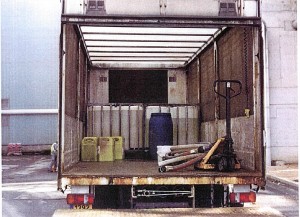A driver delivered 25% hydrochloric acid (HCl) to a household waste incineration plant at around 8 am. The lorry was transporting 3 large, 1,000-litre bulk containers of acid and another one containing 10% sodium hypochlorite (NaClO) in a single compartment. After connecting the transfer hose to the plant’s acid tank, the driver mistakenly hooked up the other end to the sodium hypochlorite bulk container, which had been intended for another client, and initiated the transfer. At 8:15 am, after 200 litres had been transferred, the employee responsible for accepting waste noticed a chlorine (Cl2) release stemming from the tank while monitoring the tank’s filling level. He suspended the operation and sounded the alarm. Despite wearing individual protective gear (a cartridge mask), the driver felt faint but still managed to walk to safety beyond the transfer zone. Notified by the Head of Operations, fire-fighters and municipal police visited the site. A safety perimeter was installed within the transfer zone. It was decided to let the reaction end of its own accord since no operable stirring mechanism could exacerbate the situation. The driver remained under observation at the hospital and was placed on a one-week leave from work. The 1,500 litres of the site’s HCl were fouled and had to be removed for destruction; the tank was thoroughly rinsed. The ion-exchange resins used to prepare the plant’s demineralised water had to be discarded. The operator deployed a mobile demineralisation unit (on a lorry) for the time it took to replace the resins.
It turned out that the bulk containers of HCl and NaClO were identical and moreover relied on the same transfer couplings. The driver’s mask was inefficient, as the cartridge had been used for several consecutive days. The supplier introduced a checklist procedure before any transfer at a client’s site and circulated an internal memo on this accident.




